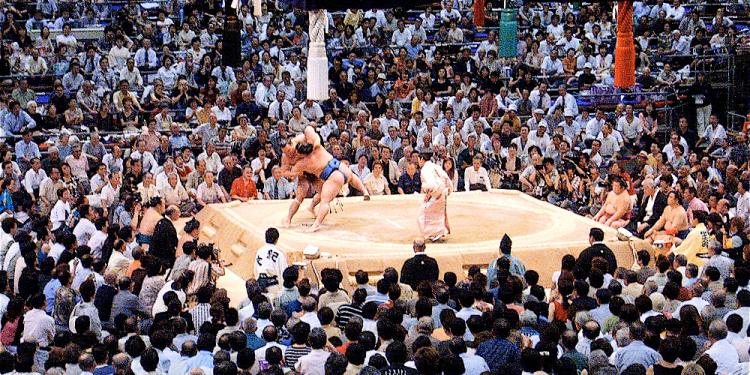Everything You’ve Ever Wanted To Know About Japanese Sumo
Posted: September 6, 2023
Updated: September 6, 2023
Dating back to the year 712, sumo wrestling has enjoyed a long history. Today, the sport is taken very seriously throughout Japan, with stables, leagues, and televised competitions. However, the idea of an extremely overweight "athlete" is beginning to lose it's shine as people become more aware of the health concerns of sumo wrestlers.

Dating back to the year 712, sumo wrestling has enjoyed a long history. Today, the sport is taken very seriously throughout Japan, with stables, leagues, and televised competitions. However, the idea of an extremely overweight "athlete" is beginning to lose its shine as people become more aware of the health concerns of sumo wrestlers.
What's The Essence of Sumo?
Sumo stands as a distinctive style of full-contact wrestling, where the primary objective is to either push your adversary, known as a sumo wrestler or rikishi, out of the Sumo ring or compel them to touch the ground with any part of their body except the soles of their feet. Originating in Japan, Sumo holds the esteemed status of being the nation's official sport. Even today, it retains various traditional rituals, such as the ritualistic use of salt. Professional sumo wrestlers adhere to a strict set of regulations stipulated by the Japan Sumo Association. Their lives are regimented within communal sumo training stables, where every moment is meticulously planned, and weight gain is a crucial factor.The Meaning Of The Word Sumo
The term "sumo" derives from the Japanese verb "sumau" or "sumafu," signifying "compete" or "fight." It is a part of the historical expression "sumai no sechi," denoting a competition from the Heian period. The characters within "sumai" or "sumō" today convey the meaning "to strike each other." In Japan, "sumo" translates to "wrestle" or "wrestling," exemplified by the official name of the sport, "ōzumō," or "grand Sumo."The Historical Tapestry Of Sumo Wrestling
Hints in prehistoric artwork suggest that Sumo may have its origins in an agricultural dance performed to celebrate bountiful harvests. The first recorded mention of the term "sumo" dates back to the year 712 when the fate of Japanese islands was decided through a bout between two deities, Takemikazuchi (the God of thunder, swordsmanship, and conquest) and Takeminakata (the God of water, hunting, wind, and agriculture), with Takemikazuchi prevailing in hand-to-hand combat. https://www.youtube.com/watch?v=uu_bwhXGiak&pp=ygUpVGhlIEhpc3RvcmljYWwgVGFwZXN0cnkgT2YgU3VtbyBXcmVzdGxpbmc%3D The inaugural sumo contest between mortal participants occurred in 23 BC when Nomi no Sukune emerged victorious over Taima no Kuehaya, marking him as the mythological progenitor of the sport characterised by its circular ring. In the era preceding the Japanese Middle Ages, these contests were unregulated and often fought to the death.Japanese Middle Ages (1185–1603)
The Kamakura period witnessed the transformation of Sumo, transitioning from a purely ceremonial martial art into a practical form of combat training for samurai. Its popularity steadily increased, and by the Muromachi period, it had become an accessible spectacle for the masses, even gaining sponsorship for its rikishi wrestlers. Those who engaged in Sumo bouts attained Samurai status and received general support. One of the pivotal moments occurred when Oda Nobunaga hosted a grand Sumo tournament for 1,500 spectators in 1578. During these events, the circular ring made its debut, primarily serving to ensure spectator safety and expedite proceedings. This innovation in Sumo's format can be credited to Nobunaga's tournament.Edo Period (1603–1867)
The Edo period experienced numerous chaotic street confrontations, prompting a temporary ban on Sumo. However, this restriction was lifted in 1684, permitting the practice of Sumo for charitable events held on the grounds of Shinto shrines. https://www.youtube.com/watch?v=Cj_QyxPZE8M&t=13s&pp=ygUpVGhlIEhpc3RvcmljYWwgVGFwZXN0cnkgT2YgU3VtbyBXcmVzdGxpbmc%3D The inaugural sanctioned Sumo tournament took place at Tomioka Hachimangu Shrine, coinciding with the establishment of the first professional wrestlers' organisation. This era produced many legendary fighters, including Tanikaze Kajinosuke, who became the first-ever Yokozuna in history during the 18th century.Since 1868
The feudal system and the era of affluent sponsors came to an end in 1868 with the Meiji Restoration. Under Western influence, Sumo had been regarded as an embarrassing pursuit, leading to internal conflicts within the central association. Nevertheless, Emperor Meiji organised a tournament for Sumo wrestlers in 1884, reigniting interest in the discipline. His influence, coupled with military victories over Korea and China, elevated Sumo to a national symbol. Eventually, in December 1925, the Japanese Sumo Association was reunified, leading to an increase in the number of annual tournaments to four. By 1958, there were six major tournaments held in a single year. Additionally, in 1949, the duration of professional wrestling tournaments was extended from 10 to 15 days.Is Sumo Wrestling Really A Sport?
Certainly, Sumo wrestling adheres to a strict set of rules that must not be violated. Competitors engage in the ring, where strikes to the crotch area or any other illegal moves are prohibited. https://www.youtube.com/watch?v=a-00BImyVOA&pp=ygUpVGhlIEhpc3RvcmljYWwgVGFwZXN0cnkgT2YgU3VtbyBXcmVzdGxpbmc%3D Unlike street fights, disqualification occurs if the rules are breached or if a wrestler intentionally exits the ring. The victor of a Sumo tournament receives considerable attention and secures a lasting place in the annals of the sport. Sumo tournament winners are highly esteemed.When Did Sumo Become Recognized As A Sport?
Sumo underwent centuries of evolution, but the emergence of the first professional wrestlers is traced back to the Edo period (1603–1867). This era introduced compensated fighters who received monetary rewards and other gifts for their participation. Today, professional Sumo is recognized as a national sport in Japan. You can even place bets on competition winners using one of the best online sportsbook sites in the UK like NetBet Sportsbook.Why Sumo Wrestling Isn't Included In The Olympics
The absence of Sumo as an Olympic sport can be attributed to the limited presence of international Sumo Federations across various countries. This scarcity of global representation makes it challenging for professional Sumo wrestlers to garner the attention of the International Olympic Committee (IOC) and secure a spot for Japan's national sport in the Olympic program. While Japan boasts the Japan Sumo Association in the land of the "Rising Sun," the worldwide network of Sumo federations remains relatively obscure.Are Sumo Wrestlers Recognized As Athletes?
Undoubtedly, Sumo qualifies as one of the most physically demanding martial arts worldwide. While some may perceive Sumo competitors as over weight, they lead rigorously disciplined lives, dedicating themselves to daily training regimens. https://www.youtube.com/watch?v=R9xHdP1zhZ4&pp=ygUpVGhlIEhpc3RvcmljYWwgVGFwZXN0cnkgT2YgU3VtbyBXcmVzdGxpbmc%3D According to online sportsbook news in the UK, even lower-ranked wrestlers maintain packed schedules, engaging in high levels of physical activity despite their size. Consequently, they face an elevated risk of health issues such as hypertension, hyperlipidemia, and glucose intolerance due to their substantial physique.Regulations And Traditions
Sumo lacks weight divisions, allowing for frequent matchups between wrestlers of vastly different sizes. It is commonplace to witness a colossal athlete facing off against an opponent weighing less than 200 pounds during tournaments. Notably, the "dohyo-iri" ceremonies, marking the wrestlers' entrance into the ring, are exclusive to those in the Juryo and Makiuchi divisions, with the west and east sides performing these rituals together. Each yokozuna, a top-division combatant, conducts an individual dohyo-iri ceremony.Sumo Rules
The primary objective of a Sumo bout is to either expel one's opponent from the ring or compel them to touch the clay surface with any part of their body besides the soles of their feet. Consequently, Sumo bouts can conclude in mere seconds. Should any part of a wrestler's body, even a fingertip, contact the ground or the outside of the straw bales demarcating the ring, they lose the bout. In cases where both wrestlers exit the ring simultaneously, the one who touches the ground first incurs the defeat. Sumo allows various techniques, including slapping, pushing, tripping, and flipping, as part of the competition. Nevertheless, actions such as kicking, striking with fists, hair pulling, eye-gouging, and targeting vital organs are strictly forbidden and result in penalties. Wrestlers are also permitted to grasp any part of their opponent's body, including the neck, and contact with the mawashi belt is deemed legal within the sport's rules.The Belt
In the world of Sumo wrestling, competitors engage in battle with bare feet, donning the distinctive "mawashi," a loincloth-like belt. This formidable piece of attire measures 2 feet in width and stretches 10 metres in length. https://www.youtube.com/watch?v=UxhKb-zZoWE&pp=ygUpVGhlIEhpc3RvcmljYWwgVGFwZXN0cnkgT2YgU3VtbyBXcmVzdGxpbmc%3D It undergoes six meticulous folds before being tightly wound around the wrestler's waist, typically entwining it four to seven times. Secured around the groin with a strap, the mawashi is a critical component of a Sumo wrestler's attire. At times, Sumo wrestlers may dampen or adjust their mawashi during matches to make themselves a more elusive target for their adversaries. Remarkably, the mawashi is at the heart of over 70 distinct Sumo techniques. The decorative cords that dangle from the front of the belt are crafted from silk stiffened with glue, though they may occasionally become detached during the intense bouts.Sumo Match
A Sumo bout commences with a "taich-ai," or initial charge. Both wrestlers adopt crouching positions, fists clenched, and eyes fixed intensely on each other. When both are prepared, they touch the knuckles of both hands to the ground and launch into action. Should one wrestler initiate prematurely, the referee signals for a fresh start, and the rule violator displays sportsmanship by bowing to their opponent and apologising. It's worth noting that prior to 2008, some combatants didn't ensure that both hands touched the ground, but this changed when the Japan Sumo Association mandated this requirement, with judges strictly enforcing the rule. Typically, a Sumo bout lasts only a few seconds, unless, of course, you are watching a match involving behemoths like Akebono and Takanohana, which can extend beyond one minute.Sumo Technique
Sumo boasts a rich array of over 70 distinct manoeuvres designed to either cast an opponent out of the ring or bring them to the ground. Among these, there are 48 officially recognized Sumo techniques, each bearing names like "beltless arm throw" or "one leg trip." The intensity of a Sumo match often kicks off with fierce slapping, followed by wrestlers engaging in clinches. https://www.youtube.com/watch?v=T-7GMEGxA6Y&pp=ygUYc3VtbyB3cmVzdGxpbmcgZXhwbGFpbmVk Some prefer to exert force to push their adversary out of the ring, while others, known as "mawashi men," excel in executing belt throws. Smaller Sumo wrestlers in the Japanese Sumo Association often employ sidesteps combined with quickness, explosiveness, and a low centre of gravity to tactically outmanoeuvre their opponents.Sumo Ring
Sumo matches take place within a sacred arena called the "dohyo." This platform measures 18 feet square and stands at a height of two feet. It is meticulously crafted from a special type of clay, designed to minimise the risk of injuries to the wrestlers. Within this space, professional Sumo wrestlers grapple and contend for victory in a 15-foot-diameter ring. This ring is encircled by twisted rice straw and covered with a layer of sand, allowing for fluid movement and sliding during the matches. Suspended above the dohyo is a Shinto shrine, held aloft by cables, while four large tassels hang from each corner, symbolising the seasons of the year—spring, summer, autumn, and winter. It's worth noting that, in adherence to traditional customs, women are prohibited from stepping onto the dohyo (ring) and entering Shinto shrines during their menstrual cycles, as they are considered "unclean." This tradition has, at times, led to unique situations, such as a female governor of Osaka being replaced by a male representative when she sought to participate in a tournament.Referees And Traditional End-of-Match Ritual
In the world of Sumo, experienced champions step into the role of judges, tasked with validating the referee's decisions and convening special meetings for resolving closely contested bouts. These judges are distinguished by their attire of black kimonos and occupy ringside seats. While there are no instant replay cameras in use, judges occasionally scrutinize the footprints and impressions left in the arena's soil before rendering a final verdict. In instances where a Sumo match is exceptionally tight, the referee's initial decision can be overturned, or a rematch may be called for. https://www.youtube.com/watch?v=nUDo026NZcA As the culmination of a Sumo bout approaches, a distinct tradition takes center stage, and it is a moment where wrestlers and spectators alike demonstrate unwavering acceptance of the referee's judgement. Regardless of victory or defeat, competitors display a remarkable stoicism in the face of outcomes. Occasionally, subtle variations in their expressions may betray their inner emotions. The defeated wrestler promptly exits the ring, while the victor lingers, rehydrates, assumes a squatting position, and garners recognition from the referee as the triumphant contender. Every day of the Sumo tournament concludes with a ceremonial "bow match," during which selected wrestlers enter the dohyo and receive a bow from the gyoji. The wrestler then twirls the bow akin to a baton, a ritual with deep historical roots dating back to Japan's Edo period. Traditionally, this bow twirling is entrusted to lower-ranked wrestlers, but ideally, the performer should hail from the Yokozuna's stable. However, on occasion, finding a suitable candidate for this role can prove challenging.The Professional Sumo Divisions
Sumo wrestling is organised into six distinct divisions: Makuuchi, comprising 42 wrestlers; Juryo, with 28 wrestlers; Makushita, housing 120 wrestlers; Sandanme, accommodating 200 wrestlers; Jonidan, hosting approximately 230 wrestlers; and Jonokuchi, with roughly 80 wrestlers. Wrestlers begin their careers in the lower divisions and strive to ascend to the pinnacle, the Makuuchi division. Remarkably, only the top two division fighters receive salaries, prompting all aspiring wrestlers to aim for the highest rank as swiftly as possible.Professional Tournaments
The Japan Sumo Association has been hosting six major tournaments annually since 1958. These tournaments take place at the Ryōgoku Kokugikan in Ryōgoku, Tokyo, during January, May, and September, and one each in Osaka (March), Nagoya (July), and Fukuoka (November). Notably, there are no consecutive tournaments or back-to-back significant events held in the Japanese capital. Each tournament commences on a Sunday and spans 15 days, culminating on the following Sunday. This extended duration presents a unique opportunity for tournament ticket holders to potentially earn extra income, as Sumo tickets are known to be quite expensive.Where To Bet On Sumo
Being a rather obscure betting sport, we highly recommend using NetBet Sportsbook for wagering on sumo. There's a £50 welcome bonus as a reward for new players signing up for the first time. They offer a huge selection of banking options and their website can be translated into 8 different languages.Click here to try the best odds at NetBet Sportsbook
Related content
Subscribe
0 Comments












